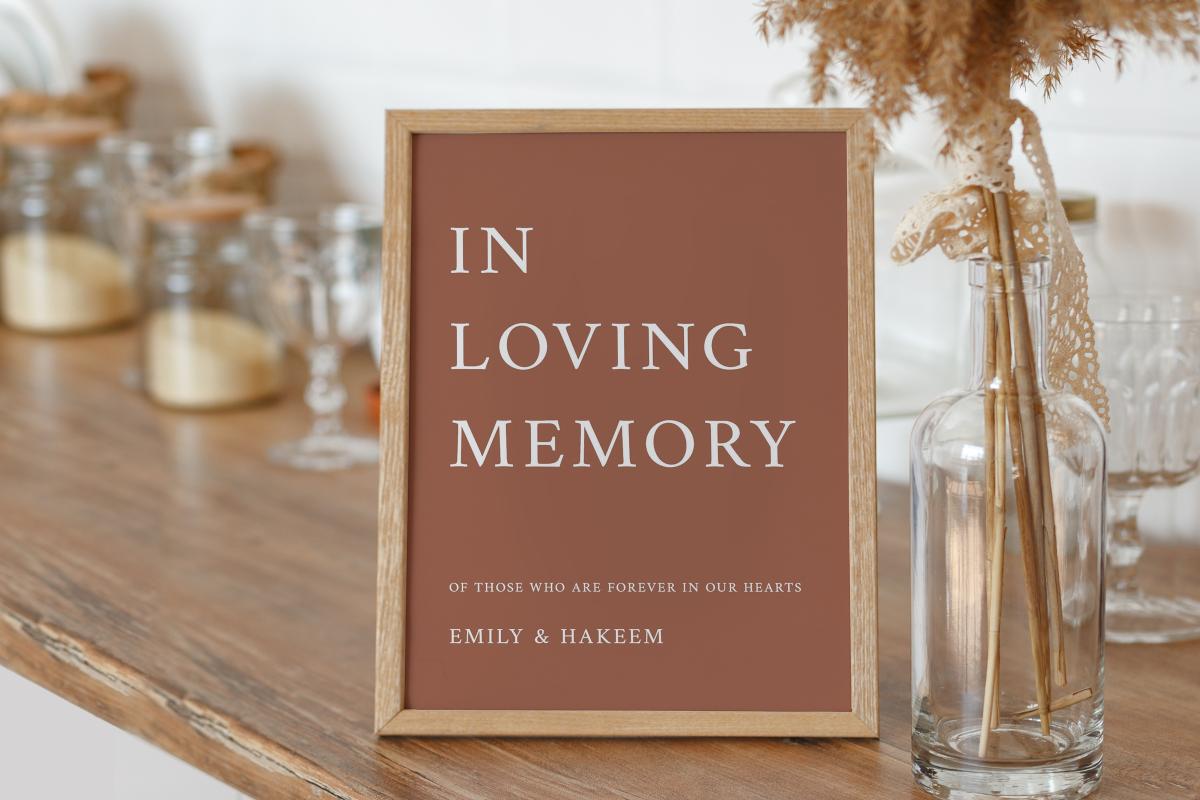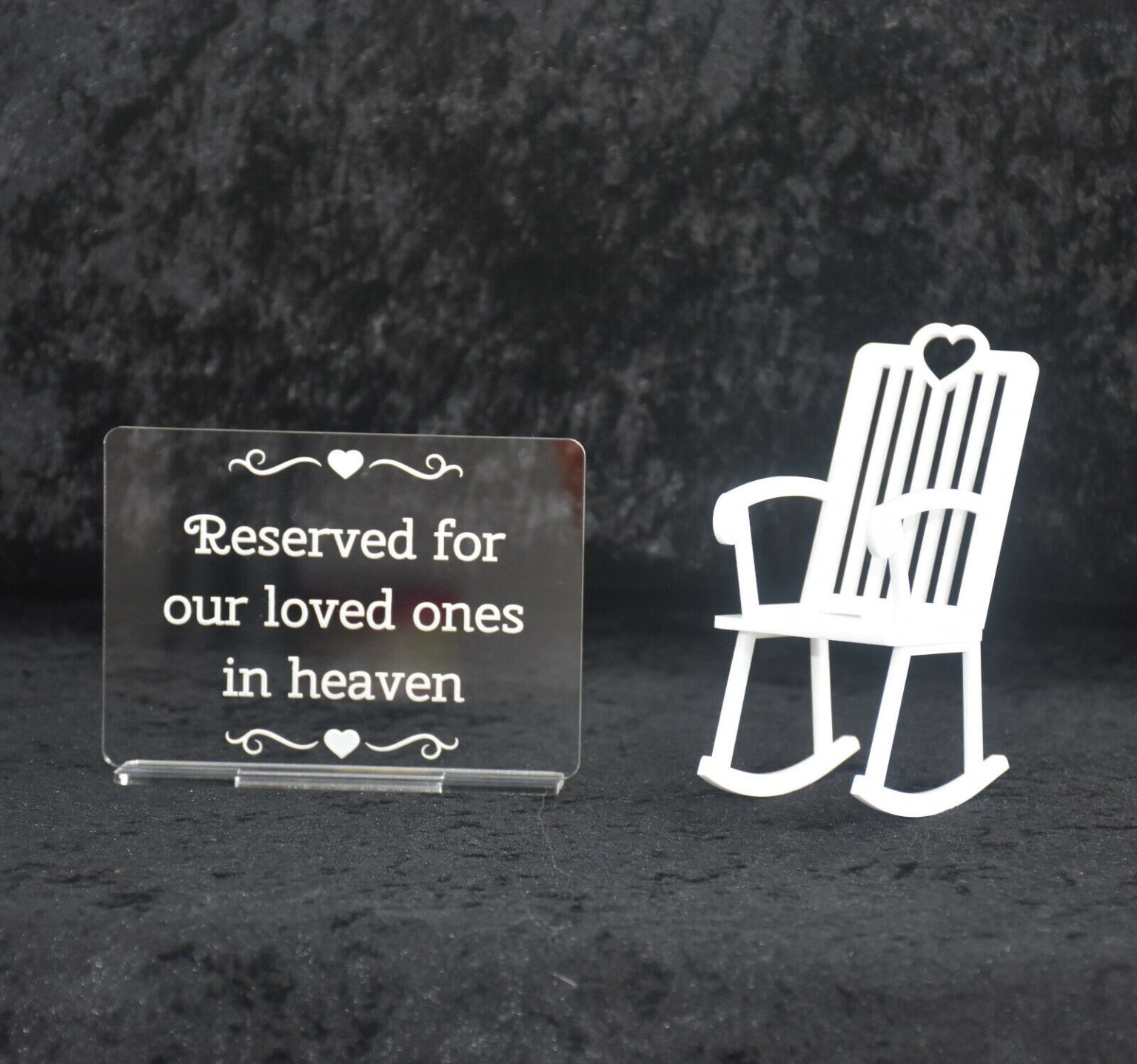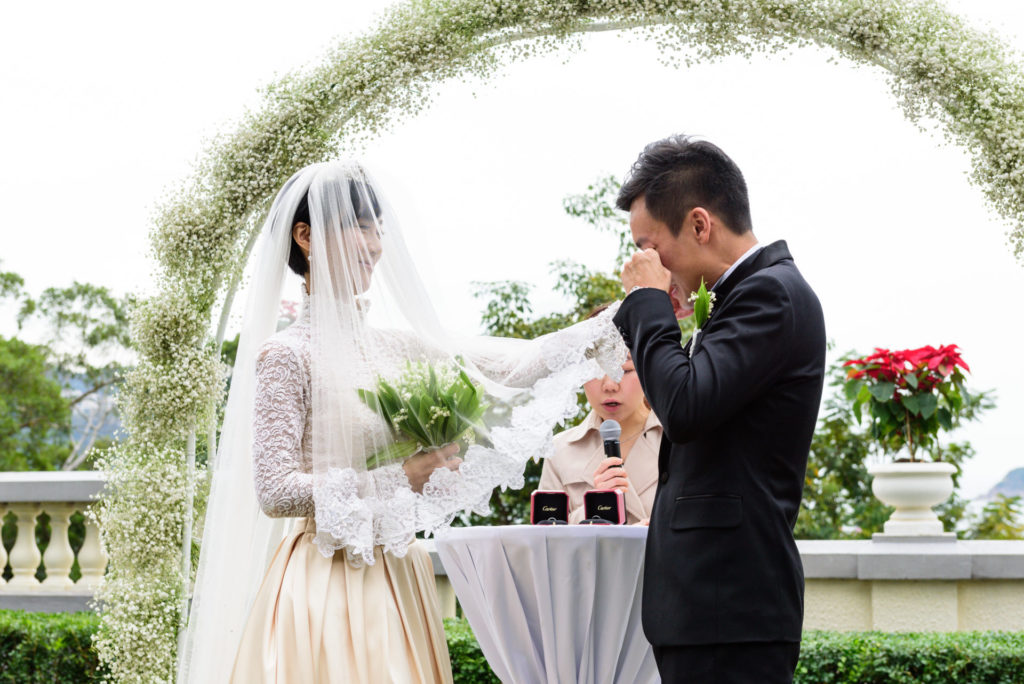Remembering a deceased parent, grand parent, family member or Pet during your wedding ceremony and reception celebration.
Remembering a loved one on your wedding day can be a beautiful and meaningful tribute. Here are some heartfelt ways to honor their memory:
Moment of Silence or Prayer:
- Timing and Placement: Determine when and where in the ceremony or reception you want to observe the moment of silence or prayer. This could be at the beginning of the ceremony to acknowledge the presence of your loved one from the outset, or it could be incorporated at a specific moment that holds significance for you, such as during a reading or before exchanging vows.
- Announcement: Before observing the moment of silence or prayer, your officiant or a designated person can make a brief announcement to inform guests of the purpose. This announcement can be heartfelt and respectful, expressing the intention to honor the memory of your loved one and inviting everyone to join in reflection.
- Creating Atmosphere: Set the tone for the moment by creating a serene and reverent atmosphere. This can be achieved through soft music, dimmed lights, or other subtle cues that signal to guests that this is a time for quiet contemplation.
- Silent Reflection: Invite everyone to take a moment of silence to reflect on the life and memory of your loved one. Encourage guests to recall fond memories, offer silent prayers, or simply pause in quiet contemplation. This allows each individual to honor the memory of your loved one in their own way.
- Optional Prayer: If appropriate based on your beliefs and the preferences of your guests, you may choose to follow the moment of silence with a brief prayer or blessing. This can be led by your officiant or another respected individual, and it can be tailored to reflect the spiritual or cultural traditions that are meaningful to you and your loved one.
- Conclusion: After the moment of silence or prayer, your officiant or another designated person can gently guide the ceremony back to its flow, transitioning to the next segment or proceeding with the planned program. This transition should be done with sensitivity and grace, acknowledging the solemnity of the moment while also recognizing the joyous occasion of your wedding.
Reserved Seat or Photo Display:
Creating a reserved seat or photo display for a loved one who has passed away is a touching way to honor their memory and acknowledge their presence on your wedding day. Here’s an elaboration on how to incorporate this tribute:
- Designating the Seat: Choose a seat in a prominent location within the ceremony space, such as in the front row or near the aisle, to designate as a reserved seat for your loved one. This ensures that their presence is felt and acknowledged by both you and your guests throughout the ceremony.
- Personalizing the Display: Place a framed photo of your loved one on the reserved seat, along with any other meaningful items or mementos that represent their life and personality. This could include flowers, candles, a favorite book, or a cherished keepsake that holds special significance to you and your family.
- Creating a Memorial Display: In addition to or instead of a reserved seat, consider setting up a small memorial display at the entrance or within the ceremony space. This display can feature photos, mementos, and other personal items that celebrate the life and memory of your loved one. Be sure to include a sign or plaque explaining the significance of the display and inviting guests to take a moment to honor their memory.
- Incorporating Symbolism: Incorporate symbolic elements into the reserved seat or memorial display that reflect the personality, interests, or cultural background of your loved one. For example, you could include their favorite flowers, colors, or religious symbols to pay tribute to their unique identity and legacy.
- Emphasizing Presence and Importance: During the ceremony, make a subtle but meaningful gesture to acknowledge the reserved seat or memorial display, such as a brief moment of silence, a heartfelt mention in your vows, or a symbolic gesture like placing a single flower on the seat in their honor. This emphasizes the presence and importance of your loved one on your special day.
- Encouraging Reflection: Invite guests to visit the reserved seat or memorial display before or after the ceremony to pay their respects and reflect on the life and memory of your loved one. This creates a space for shared remembrance and allows each guest to honor your loved one in their own way.
- Preserving the Memory: After the wedding, consider what you will do with the items from the reserved seat or memorial display. You may choose to keep them as cherished keepsakes, donate them to a meaningful cause or organization, or distribute them among family members as treasured reminders of your loved one’s presence on your wedding day.
Incorporate Their Favorite Flowers or Items:
Incorporating the favorite flowers or items of a deceased family member into your wedding can be a beautiful and personal way to honor their memory. Here’s how you can do it:
- Bouquet or Boutonniere: Include your loved one’s favorite flowers in your bouquet or the boutonnieres worn by the groom, groomsmen, or other members of the wedding party. You can either feature these flowers exclusively or incorporate them alongside other blooms that complement their choice.
- Memorial Arrangement: Create a special floral arrangement or memorial display at the ceremony or reception venue using your loved one’s favorite flowers. This could be a standalone arrangement placed in a prominent location, such as near the altar or entrance, or incorporated into existing floral décor.
- Personal Accessories: Wear or carry personal accessories or items that belonged to your deceased family member as part of your wedding attire. For example, you could incorporate a piece of jewelry, a handkerchief, a pocket square, or a tie pin that belonged to them. These items can serve as subtle but meaningful reminders of their presence on your special day.
- Incorporate Their Favorite Colors: If you’re unable to incorporate specific flowers, consider incorporating the colors that your loved one favored into your wedding decor, attire, or floral arrangements. This could involve selecting bridesmaid dresses, table linens, or other elements in their favorite hues.
- Customized Decor: Incorporate meaningful items or symbols associated with your loved one into your wedding decor. For example, you could display photos of them in vintage frames, include keepsakes or heirlooms on your reception tables, or incorporate their favorite quotes or verses into signage or stationery.
- Memory Walkway: Create a memory walkway leading to the ceremony or reception venue, lined with flowers, photos, or other meaningful items that represent your deceased family member. This can serve as a poignant tribute as guests walk to the celebration.
Memorial Memory Table:
Setting up a memorial table at a wedding to honor a loved one or family member who has passed away is a thoughtful way to include them in the celebration and pay tribute to their memory. Here’s a step-by-step guide on how to set up a memorial table:
- Select a Location: Choose a suitable location within the wedding venue for the memorial table. It should be easily accessible and visible to guests, but not in a high-traffic area where it might be disrupted.
- Table Setup: Set up a table or designated area for the memorial display. Use a tablecloth or covering that complements the wedding decor, ensuring that it provides a clean and attractive backdrop for the display.
- Decorate the Table: Decorate the table with meaningful items and decorations that honor the memory of your loved one. Some ideas include:
- A framed photo of the deceased person.
- Candles, either votive candles or larger pillar candles, to symbolize light and remembrance.
- Personal items or mementos that belonged to the deceased, such as jewelry, a favorite book, or a cherished keepsake.
- Floral arrangements, including their favorite flowers or flowers that hold significance to them.
- A memorial plaque, sign, or framed quote with a meaningful message or inscription.
- Any religious or cultural symbols that were important to the deceased or their family.
- Include a Guest Book or Memory Cards: Provide a guest book or memory cards for guests to write messages, share memories, or offer condolences. This allows guests to express their thoughts and feelings while honoring the memory of your loved one.
- Personalize the Display: Customize the memorial table with personal touches that reflect the unique personality, interests, and preferences of the deceased. Incorporate elements that celebrate their life and legacy, ensuring that the display feels authentic and meaningful.
- Consider Adding Height: Create visual interest and dimension by varying the height of items on the memorial table. Use stands, risers, or pedestals to elevate certain items, such as the framed photo or floral arrangements, while keeping other items at eye level for easy viewing.
- Arrange Thoughtfully: Arrange the items on the memorial table thoughtfully, paying attention to symmetry, balance, and spacing. Ensure that each item is positioned in a way that allows it to be seen and appreciated by guests.
- Add a Sign or Explanation: Include a sign or brief explanation near the memorial table to inform guests about its purpose and significance. This can include a message inviting guests to pay their respects, share memories, or offer prayers in honor of the deceased.
- Monitor and Maintain: Throughout the wedding reception, monitor the memorial table to ensure that it remains undisturbed and well-maintained. If necessary, designate a trusted individual to oversee the table and address any issues that may arise.
- Respectful Dismantling: At the conclusion of the wedding celebration, dismantle the memorial table with care and respect. Consider how you will handle the items displayed on the table after the wedding, whether they will be kept as keepsakes, donated to charity, or distributed among family members.
Include Their Favorite Song
Including a favorite song of a deceased loved one at a wedding ceremony can be a deeply meaningful way to honor their memory and celebrate their presence on your special day. Here’s how you can incorporate their favorite song into the ceremony:
- Selection Process: Start by choosing a song that was meaningful to your deceased loved one. Consider songs that held special significance to them, perhaps a song that they loved to listen to, a song that reminds you of them, or a song that reflects their personality or values.
- Ceremony Entrance or Prelude: Consider playing the favorite song of your deceased loved one as part of the prelude music as guests are being seated and waiting for the ceremony to begin. This sets the tone for the ceremony and creates a poignant moment of remembrance.
- Processional or Recessional: Incorporate the favorite song into the processional or recessional music. You could have it play as the wedding party enters or exits the ceremony space, creating a beautiful and heartfelt moment that honors your loved one’s memory.
- Special Musical Interlude: If the favorite song of your deceased loved one doesn’t fit naturally into the processional or recessional, consider incorporating it as a special musical interlude during the ceremony. This could be a moment of reflection or tribute, where the song is played or performed live by a musician or vocalist.
- First Dance: If the favorite song of your deceased loved one is appropriate for a first dance, consider dancing to it as a couple during the reception. This allows you to honor their memory in a more intimate setting while still sharing the moment with your guests.
- Dedication: Before playing the song or incorporating it into the ceremony, you can make a brief dedication or announcement to explain its significance. This can be a touching way to share the story behind the song and the connection to your loved one with your guests.
- Program or Signage: Include a note in your wedding program or display signage at the ceremony or reception venue to inform guests about the special significance of the song and its connection to your deceased loved one. This ensures that everyone understands the meaning behind the musical choice.
- Live Performance: If possible, arrange for a live performance of the favorite song by a musician or vocalist during the ceremony or reception. This adds a personal and heartfelt touch to the tribute and allows guests to experience the song in a more intimate and emotional way.
Include Them in Your Vows:
Light a Candle:
Incorporating a candle lighting ceremony in honor of a deceased loved one at a wedding ceremony can be a beautiful and poignant tribute. Here’s how you can include this symbolic ritual:
- Select a Meaningful Candle: Choose a special candle to represent your deceased loved one. This could be a traditional unity candle, a memorial candle, or a personalized candle with their name or a meaningful inscription.
- Designate a Special Moment: Determine the timing and placement of the candle lighting ceremony within your wedding ceremony. You may choose to include it as a standalone ritual or integrate it into a specific part of the ceremony, such as before exchanging vows or during a moment of remembrance.
- Explain the Significance: Before the candle lighting ceremony begins, the officiant or a designated speaker can provide a brief explanation to guests about the significance of the ritual and its connection to your deceased loved one. Share a few words about the person you are honoring and why their memory is important to you.
- Include Family Members: Invite family members or close friends to participate in the candle lighting ceremony. This could involve having them escort the candle to its place or assist with the lighting process, symbolizing the support and love of your broader community.
- Choose a Meaningful Location: Set up a designated space for the candle lighting ceremony within the ceremony venue. This could be a special table or altar adorned with flowers, photos, or other meaningful decorations that honor your loved one’s memory.
- Light the Candle: During the ceremony, invite the designated individuals to come forward and light the candle together. You may choose to use a smaller taper candle to light the main memorial candle, symbolizing the passing of light and love from one generation to the next.
- Moment of Reflection: After the candle is lit, take a moment of reflection or silence to honor the memory of your deceased loved one. This allows you and your guests to pause and remember the impact they had on your lives and the love that continues to endure.
- Optional Reading or Prayer: Consider including a reading, poem, or prayer that is meaningful to you and your deceased loved one as part of the candle lighting ceremony. This adds depth and resonance to the ritual and provides an opportunity for further reflection and connection.
- Incorporate Music: Choose a piece of music to accompany the candle lighting ceremony, such as a favorite song of your deceased loved one or a piece of instrumental music that evokes a sense of reverence and remembrance.
- Conclude with Gratitude: After the candle lighting ceremony, express gratitude to your guests for participating and honoring the memory of your loved one. You may also choose to offer a few words of remembrance or a final blessing before continuing with the rest of the ceremony
Share Stories or Memories:
Sharing memories of a loved one during your wedding reception is a touching way to honor their memory and include them in your celebration. Here are several ways you can do so:
- Speeches or Toasts: Ask close family members or friends to share anecdotes, stories, or heartfelt memories of your loved one during speeches or toasts. This allows others to celebrate their life and legacy with you.
- Include Their Signature Dish: If your loved one had a favorite food or dish, consider incorporating it into the reception menu as a way to honor their memory and share something special with your guests.
- Photo Slideshow: Create a photo slideshow or montage featuring images of your loved one throughout their life. Play the slideshow during the reception for guests to enjoy and reminisce about special moments.
- Share Their Wisdom or Advice: Incorporate quotes, sayings, or pieces of wisdom from your loved one into your reception decor or stationery. This allows their voice to be present and offers guidance and inspiration to you and your guests.
- Toast in Their Honor: Raise a toast in honor of your loved one during the reception. Share a few words about their impact on your life and express gratitude for the love and memories they shared with you.
Acknowledging loved ones who have died at a wedding ceremony is a meaningful way to honor their memory, include them in the celebration, and provide comfort and closure to grieving family and friends.



